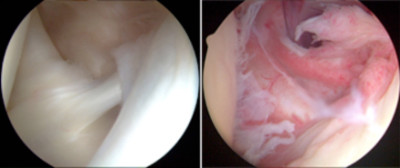Frozen shoulder, also called adhesive capsulitis, refers to stiffness and pain in the shoulder. Over time, the shoulder becomes very stiff with very limited range of motion.
Frozen shoulder occurs in about 2% of the general population. It most commonly affects people between the ages of 40 and 60, and occurs in women more often than men.
Having a better understanding of the causes and the different stages of frozen shoulder can help you take preventive measures and decide on frozen shoulder treatment methods.
Physical Examination for Frozen Shoulder
After discussing your symptoms and medical history, we will examine your shoulder. We will move your shoulder carefully in all directions to see which movements are limited and whether there is pain associated with the motion. The range of motion when someone else moves your shoulder is called “passive range of motion.” Your doctor will compare this to the range of motion you display when you move your shoulder on your own (“active range of motion”). People with frozen shoulder have a limited range of motion both actively and passively.
Imaging Tests for Frozen Shoulder
Other tests that may help your doctor rule out other causes of stiffness and pain include:
X-rays
Dense structures, such as bone, show up clearly on x-rays. X-rays may show other problems in your shoulder, such as arthritis.
Magnetic resonance imaging (MRI) and ultrasound
These studies can create better images of problems with soft tissues, such as a torn rotator cuff.
Nonsurgical Frozen Shoulder Treatment
The focus of frozen shoulder treatment is to control pain and restore motion and strength through physical therapy. More than 90% of patients improve with relatively simple treatments to control pain and restore motion.
Non-steroidal anti-inflammatory medicines
Drugs like aspirin and ibuprofen reduce pain and swelling.
Steroid injections
Cortisone is a powerful anti-inflammatory medicine that is injected directly into your shoulder joint to reduce inflammation and to facilitate movement.
Physical therapy
Specific exercises will help restore motion. These may be done under the supervision of a physical therapist or via a home program. Therapy includes stretching or range of motion exercises for the shoulder. Sometimes heat and ultrasound are used to help loosen the shoulder up before the stretching exercises.
Surgical Treatment For Frozen Shoulder
If your symptoms are not relieved by therapy and anti-inflammatory medicines, you and your doctor may discuss shoulder surgery. It is important to talk with your doctor about your potential for recovery and the risks involved with this frozen shoulder treatment.
The goal of surgery for frozen shoulder is to stretch and release the stiffened joint capsule. The most common methods include manipulation under anesthesia and shoulder arthroscopy.
Manipulation under anesthesia
During this procedure, you are put to sleep under anesthesia. We will force your shoulder to move through a large range of motion and this causes the capsule and scar tissue to stretch or tear in a controlled fashion. This releases the tightening and increases range of motion. Immediate physical therapy after surgery is extremely important to maintain this new, improved range of motion in the shoulder.
Shoulder arthroscopy
In this procedure, your doctor will cut through tight portions of the joint capsule. This is done using pencil-sized instruments inserted through small incisions around your shoulder.
In many cases, manipulation and arthroscopy are used in combination to obtain maximum results. Most patients have good outcomes with these procedures.

Recovery
After surgery, physical therapy is necessary to maintain the motion that was achieved with surgery. Recovery times vary, from 6 weeks to three months. Although it is a slow process, your commitment to therapy is the most important factor in returning to all the activities you enjoy.
Long-term outcomes after surgery are generally good, with most patients having reduced or no pain and greatly improved range of motion. In some cases, however, even after several years, the motion does not return completely and a small amount of stiffness remains.
Although uncommon, frozen shoulder can recur, especially if a contributing factor like diabetes is still present.
Looking For A Reliable Shoulder & Elbow Orthopaedic Specialist?
Fast Medical Attention, Transparent Fees
Make an appointment for comprehensive care for your Shoulder & Elbow problems!
